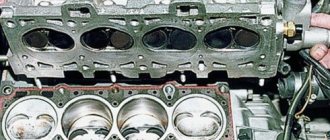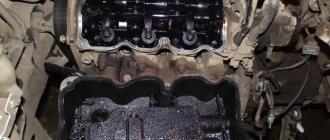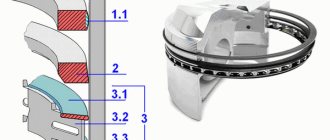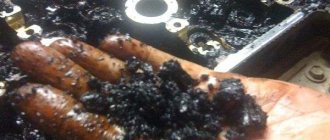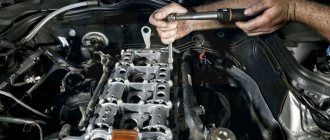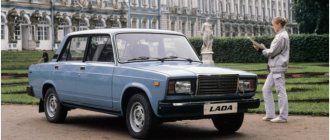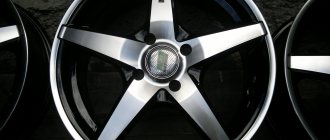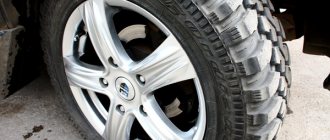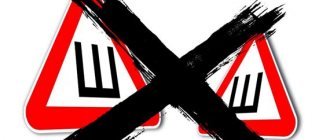How to understand when it's time to change piston rings
When the car's oil consumption increased significantly, compression in the cylinders dropped. Before quickly rushing to the garage, you need to measure the compression, first on dry cylinders and then fill the cap from a bottle of oil and measure again and compare the results. If dry cylinder performance is lower, the piston rings must be replaced.
If not, then the rings have nothing to do with it, and you should pay attention to the caps and valves. Also, if low-grade oil is used, the piston rings may become stuck. This phenomenon usually occurs in cars whose engines have not been used for a long time, or have been used for very short distances.
You can decarbonize the rings as follows: unscrew the spark plugs and pour kerosene into the cylinders overnight; this will save you from loosening the carbon deposits.
Signs and causes of wear (breakage) of piston rings
On VAZ cars, the engine wears out during operation, and the PCs also fail. Rings can:
- break into two or more parts;
- wear out in thickness;
- have general wear and tear.
Parts often break down due to overheating of the internal combustion engine; in this case, compression in the cylinders decreases and the engine loses power. Signs of a faulty PC are:
- bluish smoke from the muffler pipe, especially often it appears after a long period of idling when the gas pedal is sharply pressed;
- increased engine oil consumption;
- drop in power, the motor stops pulling;
- coking of spark plugs.
If there are signs of a malfunction in the piston group, the piston rings are replaced first. But replacing a PC does not always give the desired effect; often after repair the engine continues to smoke and consume oil. The reason for this is simple - there is wear in the cylinders themselves. In the block, the liners usually wear out unevenly - they take on an oval shape; due to wear, the piston rings do not fit tightly to the cylinder walls and do not provide a tight seal.
Dimensions and markings of piston rings VAZ 2109 – 2115
I will now give you the main dimensions of the connecting rod and piston group below in the figure.
The piston is cast aluminum. According to the outer diameter, the pistons are divided into five classes (A, B, C, D, E) every 0.01 mm. The outer surface of the piston has a complex shape. Therefore, it is necessary to measure the piston diameter only in a plane perpendicular to the piston pin, at a distance of 55 mm from the piston bottom.
Main dimensions of the connecting rod VAZ 2109 – 2115
Based on the diameter of the hole for the piston pin, pistons are divided into three classes (1, 2, 3) every 0.004 mm.
The classes of piston diameters and holes for the piston pin are stamped on the bottom of the piston (Fig. 4).
The piston is cast aluminum. According to the outer diameter, the pistons are divided into five classes (A, B, C, D, E) every 0.01 mm. The outer surface of the piston has a complex shape. Therefore, it is necessary to measure the piston diameter only in a plane perpendicular to the piston pin, at a distance of 55 mm from the piston bottom.
Dimensions of piston rings VAZ 2109 – 2115
Based on the diameter of the hole for the piston pin, pistons are divided into three classes (1, 2, 3) every 0.004 mm.
The classes of piston diameters and piston pin holes are stamped on the piston crown.
Piston markings VAZ 2109 – 2115
Piston VAZ 2114 8 valves marking
The piston group of an engine includes a piston, piston rings and a piston pin. The general design of the piston group was formed during the appearance of the first internal combustion engines. Since then, not a single element of the piston group has lost its functionality.
The piston is the most important element of any internal combustion engine.
It is this part that bears the main burden of converting the energy of expanding gases into the energy of rotation of the crankshaft. The properties that a piston must have are difficult to compatible and technically difficult to implement. Here are some requirements that this part must meet:
— the temperature in the combustion chamber can reach more than 2000°C and the piston temperature, without the risk of loss of material strength, should not exceed 350°C;
— after combustion of the gasoline-air mixture, the pressure in the combustion chamber can reach 80 atmospheres. With this pressure, the force exerted on the bottom will be over 4 tons. The thickness of the walls and bottom of the piston must ensure the ability to withstand significant loads. But any increase in the mass of the product leads to an increase in dynamic loads on the engine elements, which in turn leads to a strengthening of the structure and an increase in the weight of the engine;
— the gap between the piston and the cylinder surface should provide effective lubrication and the ability to move with minimal friction losses. But at the same time, the gap must take into account thermal expansion and eliminate the possibility of jamming.
- production must be cheap enough and meet the conditions of mass production.
The shape of the piston has changed little over the more than one hundred and fifty year history of the internal combustion engine.
In the piston design, several zones can be distinguished, each of which has its own functional purpose.
The piston crown is the surface facing the combustion chamber. The bottom, with its profile, defines the lower surface of the combustion chamber.
The shape of the bottom depends on the shape of the combustion chamber, the location of the valves, the characteristics of the supply of the fuel-air mixture to the combustion chamber and the volume of the chamber itself.
Table of nominal sizes of cylinders and pistons
| Size group | Engine model VAZ 2109 – 21099 | Engine model VAZ 2113 – 2115 | ||
| Cylinder diameter mm | Piston diameter mm | Cylinder diameter mm | Piston diameter mm | |
| A | 76,00 – 76,01 | 75,965 – 75,975 | 82,00 – 82,01 | 81,965 – 81,975 |
| B | 76,01 – 76,02 | 75,975 – 75,985 | 82,01 – 82,02 | 81,975 – 81,980 |
| C | 76,01 – 76,03 | 75,985 – 75,995 | 82,02 – 82,03 | 81,980 – 81,985 |
| D | 76,03 – 76,04 | 75,995 – 76,000 | 82,03 – 82,04 | 81,985 – 81,995 |
| E | 76,04 – 76,05 | 76,000 – 76,005 | 82,04 – 82,05 | 81,995 – 82,000 |
By weight, pistons are sorted into three groups: normal, increased and decreased by 5 g. These groups correspond to markings on the bottom of the piston: “G”, “+” and “-”.
All pistons on the engine must be of the same mass group. Repair size pistons are manufactured with an outer diameter increased by 0.4 and 0.8 mm.
An increase of 0.4 mm corresponds to a marking in the form of a triangle, and an increase of 0.8 mm corresponds to a marking in the form of a square. The arrow on the piston crown shows how to properly orient the piston when installing it into the cylinder. It should be directed towards the camshaft drive.
Marking of the connecting rod: 1 – class of the connecting rod by weight and by the hole in the upper head. 2 – cylinder number
The piston pin is a hollow steel, floating type, which rotates freely in the piston bosses and connecting rod bushing. The pin is secured in the piston hole by two retaining rings. According to the outer diameter, the fingers are divided into three classes every 0.004 mm. The class is marked with paint on the end of the finger: a blue mark is the first class, a green mark is the second class, and a red mark is the third class.
Places where metal can be removed when adjusting connecting rod heads
The piston rings are made of cast iron. The upper compression ring has a chrome-plated barrel-shaped outer surface. The lower compression ring is scraper type. The oil scraper ring has chrome-plated working edges and an expansion coil spring. Repair size rings are marked digitally “40” or “80”, which corresponds to an increase in the outer diameter by 0.4 or 0.8 mm.
The connecting rod is steel, forged. The connecting rod is processed together with the cover and therefore they are individually non-interchangeable. To avoid mixing up the caps and connecting rods during assembly, they are marked with number 2 (Fig. 5) of the cylinder in which they are installed. A steel-bronze bushing is pressed into the upper head of the connecting rod.
Based on the diameter of the hole in this bushing, the connecting rods are divided into three classes every 0.004 mm. The class number 1 is stamped on the connecting rod cover. Based on the weight of the upper and lower heads, connecting rods are divided into classes, marked either with a letter or with paint on the connecting rod cover. Connecting rods of the same weight class must be installed on the engine.
| Classes of connecting rods based on the weight of the upper and lower heads | |||
| Mass of connecting rod heads, g | Class | Marking color | |
| top | bottom | ||
| 184+2 | 489+3 495+3 501+3 | F L B | Red Green |
| 188+2 | 489+3 495+3 501+3 | X M IN | |
| 192+2 | 489+3 495+3 501+3 | C N G | Blue |
The weight of the connecting rods can be adjusted by removing metal from the bosses on the upper head and on the cover to a minimum size of 33 and 32 mm (Fig. 6). After removing the metal from the connecting rod cap, it is necessary to mark the classes of the connecting rod on it by the hole for the piston pin and by weight.
Piston VAZ 2114 8 valves marking
The piston stroke of the VAZ 2114 car engine varies from 71 to 75.6 (mm), the compression ratio - from 9.6 to 9.8 units.
An engine piston is a cylindrical part that serves to ensure the tightness of the combustion chamber and convert fuel energy into mechanical work of the engine.
The material for the manufacture of pistons on the VAZ 2114 is an alloy of aluminum and tin.
Characteristics of pistons for VAZ 2114 1.5 MT:
- Piston stroke: 71 (mm);
- Compression ratio: 9.8;
- Years of production: 1994 - 2022.
Characteristics of pistons for VAZ 2114 1.6 MT:
- Piston stroke: 75.6 (mm);
- Compression ratio: 9.6;
- Years of production: 2004 - 2022.
Important: as a rule, a failed piston cannot be repaired or restored and is replaced with a new product.
Other designations for the VAZ 2114 hatchback on the Russian market: VAZ 2108, VAZ 2109, VAZ 2113, Lada Samara.
Important: years of production of all modifications of the model: 2001-2013.
| General view General view of the pistons |
Caution: The above data are the official figures of the manufacturer, however, please note that the information is for reference only and is not guaranteed to be completely accurate.
Source of the article: https://razmery.info/tehnika/porshni/razmery-porshney-vaz-2114.html
Review of popular models of piston rings VAZ 2109 – 2115
There are many companies that produce piston rings, as well as many fakes, and there is simply not enough time to look through them all. Therefore, let's look at those manufacturers of piston rings that differ from others in normal quality and price. The first thing I want to recommend is SM piston rings.
Piston rings from SM
And
Piston rings from Mahle.
These companies produce piston rings for VAZ cars of various diameters and are perfect for us. They are most likely produced in China, because the original ones will cost much more. But this does not mean that everything is so bad, their quality is excellent. I still recommend rings from “SM”, because their price is much lower than that of “Mahle”, and the quality is the same, so why pay more and overpay for the brand.
The upper compression ring from these manufacturers is chrome-plated steel, but from the “SM” company it is copper-plated, this is clearly visible in the top photographs. The second compression ring is black and made of cast iron, but the ring from Mahle has a darker color. On the picture
The lower oil scraper rings are metal typesetting. The graphics on the left are “SM”, and on the right “Mahle”.
I recommend using metal oil scraper rings, because, unlike box-type rings, they fit perfectly in the cylinder, are resistant to overheating (they do not lose their spring properties) and their main advantage is that they work as two rings independent of each other. The rings are box-type, very afraid of overheating. When they overheat, they lose their spring properties and do their job poorly. And one more serious disadvantage: they require very careful running-in. At the slightest deviation from the running-in conditions, the working edges of the ring may break off in some places and allow oil to leak through.
Of course, there are other manufacturers of piston rings, but as usual they are complete fakes and sometimes it’s not possible to choose quality ones
Thermal clearance of piston rings
PCs are spring discs with one cut - when installed on the piston, they expand, and in the sleeve they are pressed tightly against its walls. In order to achieve maximum compression of the working mixture, the cylinder walls must be as smooth as possible (without defects), and the shape of the internal cavity must be perfectly round. On the piston, the PCs are placed in special grooves, moreover, they are not seated tightly, and on a cold piston they move freely in the grooves.
Piston rings have thermal clearances:
- between PC and groove;
- at the junction.
The clearances must be certain; if they are larger or smaller than the required value, the piston group will quickly fail. One should take into account the fact that when heated, the metal expands, and if the thermal gap of the PC is too small, the piston group will begin to overheat. With large gaps, tightness is not ensured and power losses occur.
For passenger cars, as a rule, the following clearances are established:
- between the grooves and the PDA - from 0.02 to 0.08 mm (for the upper ring the gap should be slightly larger);
- between grooves and MPC – from 0.05 to 0.06 mm;
- at the junction - from 0.25 to 0.5 mm.
As wear occurs, the gaps in the PC increase, and they should not exceed:
- between the ring and the groove – 0.15 mm;
- at the junction – 1.0 mm.
Replacing piston rings
On VAZ cars, as well as on all other models of passenger cars, it is advisable to change only the piston rings only if:
- there is no exhaust in the cylinders;
- there are no signs of damage to their inner surface.
If the liners are significantly worn, they need to be bored, and if the last size was already used before, the cylinder block needs to be relined. You can replace the PC on any VAZ engine without removing the internal combustion engine; this will require removing the cylinder head and oil sump. PCs are replaced if the gap at the joints does not exceed 1 mm.
For example, let's consider replacing piston rings on a VAZ-2114 car with an 8-valve internal combustion engine; such work must be carried out on a pit or a car lift:
- turn off the ignition, put the gearbox in neutral, disconnect the negative terminal from the battery;
- drain the antifreeze, remove the air filter housing along with the pipe (injector corrugation);
- remove the valve cover, camshaft, loosen the timing belt and move it to the side;
- disconnect the wires and cooling system pipes from the cylinder head, unscrew the head bolts;
- unscrew the nuts of the exhaust pipe of the muffler;
- We completely free the cylinder head from all fasteners that prevent it from being removed, and we remove the cylinder head;
- if there is protection under the engine, remove it;
- place a container under the engine sump, unscrew the plug on the crankcase, drain the oil;
- remove the lower hatch of the gearbox housing (three bolts);
- Using a 10 mm wrench or a socket wrench, unscrew all the oil pan bolts;
- dismantle the pan, remove the oil receiver;
- Unscrew the connecting rod nuts, remove the lower connecting rod caps, and carefully knock the pistons and connecting rods upward. Pistons should be knocked out through a soft metal drift or through a wooden block. First, you need to carefully knock out the connecting rod bolt without damaging the threads on it, then place the drift on the end of the connecting rod - in no case should you hit the bearings or the seat underneath them;
- It is recommended to remove the connecting rods one at a time, and immediately attach the caps to them; the caps should not be confused with each other, they are placed back strictly in their places, and a lock to the lock is required;
- remove the PC from the pistons, use a piece of the old ring to clean the piston grooves to bare metal. Be sure to check the cleanliness of the groove all around; there should be no coke left in it;
- We install new rings in the grooves, start with the lower MPC, then install the middle compression PK, and lastly the upper one. For installation, you can use a special device, but it is still more convenient to install the rings by hand. If the MPCs are cast iron, they cannot be bent along their axis, they can only be carefully moved apart. Compression rings also need to be bent carefully, to a minimum;
- we install the piston in place using a special mandrel, hammer it in with a wooden hammer handle or a brass or bronze drift;
- We install one piston-rod at a time, and immediately attach a connecting rod cap to each one. The connecting rod nuts should be tightened with a torque wrench, force - from 4.5 to 5.5 kg;
- then we put everything in place - the oil receiver, the engine sump, the cylinder head. We fill the radiator with antifreeze, oil into the crankcase, and start the engine to check. After replacing the PC, the internal combustion engine may initially smoke and consume oil - the engine needs to be run in for approximately 2 thousand km. It happens that despite the seemingly normal condition of the liners, the internal combustion engine continues to smoke even after replacing the rings after break-in. In this case, you will have to bore the cylinders and install a repair piston group.
VAZ piston rings
The Volzhsky Automobile Plant produces engines for front-wheel drive and rear-wheel drive cars; piston rings for VAZ engines were originally supplied by the Michurinsky plant. The Michurins produced a lot of defects in their products, and since 1986, their own production was established in Tolyatti. Currently, there are many different manufacturers that produce PCs for VAZ engines, in particular, these are:
Related Posts
Replacing (removing and installing) the cylinder head with your own...
Tire welding saves money on tires
Replacing valve seals yourself
- AVTOVAZ (Tolyatti);
- STK (Samara);
- GOETZE (Germany);
- MAHLE (Germany);
- NPR EUROPE (formerly SM, Japan).
Decarbonization of piston rings
If the engine starts to smoke, there is a possibility that there are rings stuck in the piston grooves. Nowadays, there are many different modern means for decarbonizing piston rings, and many drivers use them to restore engine performance. Among the most popular compositions are:
- Nitrox Power;
- LAVR ML-202;
- Titanium;
- LIQUI MOLY;
- WYNN'S.
Motorists believe that if the engine starts smoking, you need to use a decarbonizer, and the engine will work as before, without oil consumption and without smoke. Indeed, sometimes these remedies help, but only in cases where the motor has stood motionless for a long time (for example, after winter), and moisture has accumulated in it.
But if, after all, a forgetful car owner has not taken preventive measures, you can use a decarbonizer. We get rid of rust in cylinders as follows:
- pull off high-voltage wires;
- unscrew all spark plugs;
- rotate the crankshaft so that all pistons are in the middle position;
- pour 45 ml of liquid into each cylinder, install spark plugs;
- leave the cylinders to “soak” for 6-7 hours;
- why do we turn out the spark plugs, turn the starter a few revolutions so that all the dirt flies out of the engine;
- We put the removed parts back in place and start the engine. At first it may smoke a lot, but then the smoke will go away.
Car owners should remember that decarbonization is not a panacea for all ills, and if the piston rings are worn out, then only replacing them will help.
Related articles:
- Types of tuning of the VAZ 2110: tuning of headlights, interior, bumper, engine. The technical characteristics and appearance of the car do not always suit car owners, and drivers often try to improve their car. All operations to improve the design and [...]
- Types of interior tuning on a VAZ 2107 car Rear-wheel drive VAZ classic cars are no longer produced in Russia, and have recently become less common on the roads, however, the cars are still quite popular and in demand. […]
- Problems with VAZ 2110 fuel pumps The VAZ 2110 fuel pump can be mechanical or electric, its type depends on the type of fuel system installed on the engine. Fuel pump (BN) on carburetor internal combustion engines of cars 2110 […]
